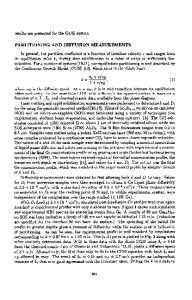Development of Morphological Instability and Cells during Rapid Solidification of Laser Annealed Silicon Alloys
- PDF / 1,563,575 Bytes
- 6 Pages / 417.6 x 639 pts Page_size
- 96 Downloads / 301 Views
553
DEVELOPMENT OF MORPHOLOGICAL INSTABILITY AND CELLS DURING RAPID SOLIDIFICATION OF LASER ANNEALED SILICON ALLOYS*
J. NARAYAN AND C. W. WHITE Solid State Division, Oak Ridge National Laboratory,
Oak Ridge,
TN 37830
ABSTRACT The details of morphological instability occurring during rapid solidification have been studied in In+, Ga+, Sb+, Bi+, Ge+, Fe+ and Cr+ implanted silicon specimens after pulsed laser annealing. The average cell sizes were determined at the onset of instability and in the region of well-developed instability using x-section and plan-view electron microscopy. The total and substitutional solute concentration profiles were determined using Rutherford backscattering and channeling techniques. The formation of cells and the critical solute concentrations associated with instability were studied as a function of velocity of solidification, which was varied by controlling the substrate temperature or the laser parameters. The results on the cell formation and the critical solute concentrations were compared with the predictions of the perturbation theory which took into account the dependence of distribution coefficients on the velocity of solidification. A good agreement between the calculations and the experimental results was obtained. We also examined theoretically the effect of reduction in surface tension due to segregation of impurities on cell sizes and critical solute concentrations associated with instability.
INTRODUCTION Laser radiation with wavelengths in the visible part of the solar spectrum is heavily absorbed in metals and semiconductors such as Si and GaAs. The irradiation by short, intense pulses of laser light can result in very rapid heating of near surface regions of these materials, followed by a similar rapid cooling in which the heat-flow can be made essentially unidirectional into the solid. 1 Heating and cooling rates exceeding 108 Kscan be realized from nanosecond laser pulses. The calculated crystal growth rates associated with the nanosecond laser pulses are of the order of several meters per second (1,2]. These growth rates can be controlled by varying either the laser parameters (pulse duration, pulse energy density, etc.) or the sample temperature during laser irradiation. Thus laser-melt quenching lends itself to detailed studies of rapid solidification. We have studied solute concentrations at the onset of instability and the wavelength (cell size) of instability [3] for Si-In, Si-Ga, Si-Sb, Si-Bi, Si-Ge, Si-Fe and Si-Cr systems. The experimental results were compared with the calculations based upon the perturbation theory, originally developed by Mullins and Sekerka [4]. In this theory, we have incorporated the dependence of interfacial distribution coefficent upon the velocity of solidification. *Research sponsored by the Division of Materials Sciences,
U. S.
Department of
Energy under contract W-7405-eng-26 with the Union Carbide Corporation.
554 EXPERIMENTAL Silicon single 6crystals ( or1 2 orientations) were implanted with 9 1 2 9 1151n+ (125 keV),
Data Loading...







